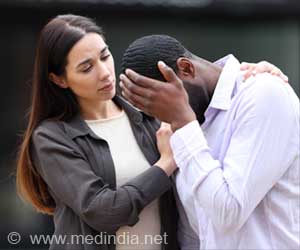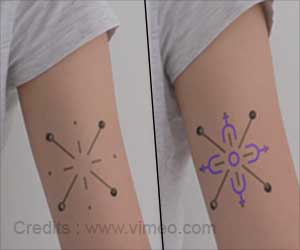The rise of memorial tattoos in Israel symbolizes collective grief and personal identity in the wake of recent tragedies.

Embodied memories - exploring memorial tattoos through the lens of terror management theory
Go to source). In response to these events, a notable trend emerged: memorial tattoos. These tattoos, which serve as body art to honor deceased loved ones, encapsulate both personal experiences of loss and a broader expression of grief, hope, and empowerment. They act as physical manifestations of emotional connections and individual stories while also symbolizing the collective trauma felt by the nation.
‘Tattoos are powerful symbols of resilience and hope, connecting personal and collective trauma. #medindia #tattoos’





Memorial Tattoos as Expressions of Grief in Israel
A study conducted by Dr. Ayelet Oreg, Dr. Hilit Erel-Brodsky, and Prof. Orit Taubman-Ben-Ari from Bar-Ilan University’s Weisfeld School of Social Work investigates the rise of memorial tattoos in Israel following the attacks through the lens of Terror Management Theory (TMT), proposed by Solomon et al. in 1991. TMT suggests that the awareness of mortality leads to existential anxiety, which individuals cope with through cultural beliefs, self-esteem, and social bonds.The researchers analyzed data from public Facebook groups and Instagram accounts of tattoo artists, collecting 250 images of memorial tattoos. They used a combination of digital ethnography and visual data analysis to explore war-related tattoos as testimonials of experiences from the October 7 massacre and the subsequent war, focusing on how the tattoos serve as expressions of collective grief and cultural identity, and may assist individuals to contend with the trauma and the existential terror of death.
The analysis of the 250 memorial tattoo photos yielded three main themes:
1. Memorial tattoos as a means for validating cultural worldviews:
Many tattoos incorporated Holocaust symbols and Israeli national imagery, reflecting a reaction to the trauma of the attacks and a connection to collective historical memories.
Memorial Tattoos: Connecting Holocaust Memory to Modern Trauma
These memorial tattoos showcase the collective memory of Israeli Jews regarding the Holocaust. The tattoos feature symbols like the yellow star and the Star of David, accompanied by the phrase “never again,” linking past trauma to present experiences. The date 7.10.23, which marks a recent tragedy, is inscribed on many arms and is reminiscent of the identification numbers imprinted on the arms of Jews during the Holocaust. Additional symbols, such as tefillin (phylacteries), a set of small black leather boxes with leather straps containing scrolls of parchment inscribed with verses from the Torah, and barbed wire, strengthen the emotional connection between Holocaust trauma and recent loss. These tattoos affirm a commitment to Judaism and reflect collective religious beliefs.
Advertisement
Tattoos of Strength and National Identity in Israel
These tattoos, particularly maps of Israel and representations of lions and lionesses, evoke themes of strength, courage, and connection to the tribe of Judah, as lions symbolize both the tribe and the Israel Defense Forces (IDF). In the aftermath of the October massacre, such tattoos reflect a nationalistic worldview defense, emphasizing emotional ties to the land.
One notable tattoo depicts a hand emerging from a grave clutching the Israeli flag, symbolizing resilience and the bond between past and present. Other tattoos express love and protection of the land, often accompanied by biblical references and poignant lyrics, such as "I have no other land,” reflecting collective grief and memory.
Advertisement
2. Memorial tattoos as a means of strengthening self-esteem:
The tattoos acted as affirmations of personal and cultural identity, helping individuals cope with existential anxiety in the wake of violence.
Memorial Tattoos Reflecting Battle Experiences and the Nova Massacre
These tattoos commemorate experiences from battles and the tragic Nova music festival massacre.One tattoo depicts a bomb explosion with destroyed buildings and 11 angels representing the soldiers killed in that battle, alongside the name "NOVA," featuring a broken heart symbolizing loss. Another tattoo shows a wolf and hints at tunnels beneath the destruction, while the third features a Merkava tank and the Israeli flag. These tattoos encapsulate personal war memories for the soldiers who adorn them.
Additionally, many tattoos emerged among survivors and victims' relatives following the Nova massacre, characterized by red and black colors reminiscent of the festival logo. Common inscriptions like "all of us" and "we shall dance again" highlight unity, resilience, and a determination to reclaim joy after tragedy. These tattoos foster a sense of belonging and pride among those affected.
Tattoos as Affirmations of Identity and Resilience
These tattoos serve as public affirmations of identity and self-worth. Examples include expressions of Jewish identity and statements related to October 7, emphasizing a connection to community and resilience.
One tattoo transforms "impossible" to "possible," symbolizing strength and survival, while another, featuring the phrase "release our hostages" along with a quote from Jewish visionary Theodore Herzl, reflects a belief in overcoming challenges. A tattoo that inscribes "home" alongside a heartbeat graphic conveys resilience and connection to one’s homeland.
3. Memorial tattoos as a reflection of the desire to achieve proximity to deceased loved ones and places affected by the war:
Tattoos symbolized a longing to connect with deceased loved ones and places impacted by the conflict.
Tattoos as Symbols of Love and Connection to the Departed
These tattoos provide their bearers with a sense of closeness to their loved ones, offering comfort and strength in facing the anxieties of death and mourning.
Tattoo images include a lifelike representation of a fallen soldier and a poignant tribute, for example, from a brother to his deceased sibling featuring the phrase "Always with me." Other tattoos portray the departed as angels, and one illustrates a scene of companionship with the inscription "never alone," symbolizing a perpetual bond between the living and the deceased.
Tattoos as Reminders of Places and Symbols of Resilience
These images emphasize a connection to specific places in Israel where the atrocities were suffered. One tattoo represents a police station in Sderot, which was heavily damaged and became a site of loss, while another symbolizes Kibbutz Kfar Aza, where many residents were killed or abducted. These tattoos serve as emotional reminders of cherished memories tied to these locations.
Additionally, wheat tattoos symbolize renewal and life, referencing Israel's agricultural heritage and the resilience captured in a poignant war song about the Yom Kippur War. Red poppies and anemones are also highlighted, representing endurance amidst adversity and connecting to the trauma of the recent conflict in a region known for an annual festival showcasing its fields bursting with these blooming red flowers. These tattoos reflect a desire to maintain a bond with nature and the region's history, encapsulating themes of hope and survival.
“Following traumatic events, such as the 9/11 attacks in the United States, people often express nationalism through symbols, such as memorial tattoos, which serve as coping mechanisms to mitigate the extensive anxiety,” say Dr. Oreg, Dr. Erel-Brodsky and Prof. Taubman – Ben-Ari, who led the study.
This study of the October 7 onslaught, published in the journal Death Studies, offers insights into how individuals cope with trauma and find meaning through tattoos, using TMT as a theoretical framework, ultimately contributing to the understanding of psychological resilience in the face of terror. By exploring how these tattoos function as a means of processing trauma, the study furthers understanding of the broader implications of TMT in real-world contexts and can contribute to the development of strategies for mitigating the psychological impact of terrorism and mass crises.
Reference:
- Embodied memories - exploring memorial tattoos through the lens of terror management theory - (https://www.tandfonline.com/doi/full/10.1080/07481187.2024.2414275)
Source-Medindia










